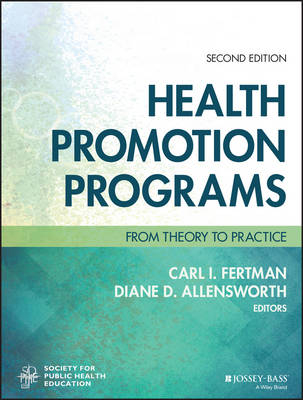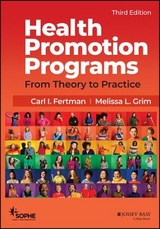
Health Promotion Programs
John Wiley & Sons Inc (Verlag)
978-1-119-16333-6 (ISBN)
- Titel ist leider vergriffen;
keine Neuauflage - Artikel merken
Comprehensive coverage, real-world issues, and a focus on the practical aspects of health promotion Health Promotion Programs combines theory and practice to deliver a comprehensive introduction to the planning, implementation, and evaluation of health promotion programs. Presenting an overview of best practices from schools, health care organizations, workplaces, and communities, this book offers clear, practical guidance with an emphasis on hands-on learning. This new second edition has been updated to include discussion on today's important issues, including health equity, the Affordable Care Act, big data, E-health, funding, legislation, financing, and more. New coverage includes programs for underserved priority populations at a geographically-diverse variety of sites, and new practice and discussion questions promote engagement on highly-relevant topics. Public health is a critical aspect of any society, and health promotion programs play an important role. This book provides clear instruction, practical guidance, and multiple avenues to deeper investigation.
* Plan health promotion programs from the basis of health theory * Gain in-depth insight on new issues and challenges in the field * Apply what you're learning with hands-on activities * Access digital learning aids and helpful templates, models, and suggestions Designed to promote engagement and emphasize action, this book stresses the importance of doing as a vital part of learning yet each step of the process is directly traceable to health theory, which provides a firm foundation to support a robust health promotion program. Health Promotion Programs is the essential introductory text for practical, real-world understanding.
CARL I. FERTMAN, PD, MCHES, is an Associate Professor in Health and Physical Activity and the Executive Director of the Maximizing Adolescent Potentials (MAPS) Program at the University of Pittsburgh School of Education. DIANE D. ALLENSWORTH, PD, is Professor Emeritus at the Kent State University College of Education. SOCIETY FOR PUBLIC HEALTH EDUCATION (SOPHE) is the leading international professional association for health education professionals, faculty, and students. Founded in 1950, SOPHE is the only independent professional organization devoted exclusively to health education and health promotion in all settings.
List of Figures and Tables xv Editors xix The Contributors xxi SOPHE xxv Preface xxvii Acknowledgments xxxiii Part One: Foundations of Health Promotion Programs 1 Chapter 1 What Are Health Promotion Programs? 3 Carl I. Fertman, Diane D. Allensworth, and M. Elaine Auld Health, Health Promotion, and Health Promotion Programs 3 Historical Context for Health Promotion 6 Healthy People: A National Public-Private Partnership to Promote Health 10 Impact of the Patient Protection and Affordable Care Act on Health Promotion 12 Health Education and Health Promotion 15 Settings for Health Promotion Programs 16 Stakeholders in Health Promotion Programs 19 Advisory Boards 20 Health Promotion, Health Care, and eHealth 21 Summary 23 For Practice and Discussion 23 Key Terms 24 References 25 Chapter 2 Advancing Equity and Eliminating Health Disparities 29 Francisco Soto Mas, Diane D. Allensworth, Camara Phyllis Jones, and Holly E. Jacobson Population Groups Experiencing Health Inequities and Disparities 29 Understanding Racial and Ethnic Differences in Health 36 Program Strategies to Achieve Health Equity and Eliminate Health Disparities Among Minorities 37 Engage Minority Groups and Communities Directly in Addressing Health Promotion Issues 38 Summary 46 For Practice and Discussion 47 Key Terms 48 References 48 Chapter 3 Theory in Health Promotion Programs 53 Melissa Grim and Brian Hortz Theory in Health Promotion Programs 53 Foundational Theories/Models: Intrapersonal Level 55 Foundational Theories/Models: Interpersonal Level 59 Foundational Theories/Models: Population Level 62 Foundational Theories/Models Applied Across the Levels 66 Health Promotion Program Planning Models 67 Using Health Theories and Planning Models 75 Summary 75 For Practice and Discussion 76 Key Terms 77 References 77 Part Two: Planning Health Promotion Programs 83 Chapter 4 Assessing the Needs of Program Participants 85 James H. Price, Joseph A. Dake, and Britney Ward Defining a Needs Assessment 85 Conducting a Health Needs Assessment 92 Promoting a Needs Assessment 92 Using Primary Data Methods and Tools 93 Using Secondary Data Methods and Tools 99 Reporting and Sharing the Findings 101 Summary 107 For Practice and Discussion 108 Key Terms 109 References 110 Chapter 5 Making Decisions to Create and Support a Program 113 Jiunn-Jye Sheu, W. William Chen, and Huey-Shys Chen Identifying a Mission Statement, Goals, and Objectives 113 Writing Program Objectives 115 Deciding on Program Interventions 119 Selecting Health Promotion Materials 122 Using Evidence-Based Interventions 124 Developing Effective Policies and Procedures 130 Transitioning to Program Implementation 135 Summary 137 For Practice and Discussion 138 Key Terms 139 References 139 Part Three: Implementing Health Promotion Programs 141 Chapter 6 Implementation Tools, Program Staff, and Budgets 143 Jean M. Breny, Michael C. Fagen, and Kathleen M. Roe From Program Planning to Action Planning 143 Preparing a Logic Model 145 Using a Gantt Chart to Guide Implementation 149 Additional Implementation Planning Tools 152 Planning for Implementation Challenges 153 Hiring and Managing High-Quality Program Staff 157 Budgeting and Fiscal Management 161 Summary 166 For Practice and Discussion 167 Key Terms 168 References 168 Chapter 7 Advocacy 171 Regina A. Galer-Unti, Kelly Bishop, and Regina McCoy Pulliam Creating an Advocacy Agenda for a Program 171 Advocacy as a Professional Responsibility 174 Examples of Successful Health Policy Advocacy 175 Becoming Fluent in the Language of Advocacy 176 Forming Alliances and Partnerships for Advocacy 181 Advocacy Methods 183 Advocacy and Technology 189 Summary 189 For Practice and Discussion 190 Key Terms 191 References 191 Chapter 8 Communicating Health Information Effectively 193 Neyal J. Ammary-Risch, Allison Zambon, and Ellen Langhans Communication in Health Promotion Programs 193 Developing a Communication Plan for a Site 201 Developing and Pretesting Concepts, Messages, and Materials 207 Summary 214 For Practice and Discussion 215 Key Terms 216 References 216 Chapter 9 Where Money Meets Mission: Developing and Increasing Program Funding 219 Carl I. Fertman, Karen A. Spiller, and Angela D. Mickalide Knowing Program Funding 219 Sources of Program Funding 220 Funding Varies by Program Participants and Setting 224 Writing a Grant Proposal 226 Maintaining Relationships with Funders 232 Fundraising 234 Working with Board Members 237 Summary 239 For Practice and Discussion 239 Key Terms 240 References 240 Part Four: Evaluating and Sustaining Health Promotion Programs 243 Chapter 10 Evaluating Health Promotion Programs 245 Joseph A. Dake and Timothy R. Jordan Why Evaluate a Health Promotion Program? 245 How Do I Get Started? 246 Evaluation Frameworks 257 Evaluation Design 260 Data Collection and Analysis 263 Evaluation Reports 264 Implementing an Evaluation 266 Summary 270 For Practice and Discussion 271 Key Terms 272 References 272 Chapter 11 Big Data and Health Promotion Programs 275 Carl I. Fertman, Joseph A. Dake, and Margaret Wielinski What Is Big Data? 275 Data Mining with Health Promotion Big Data 279 Big Data Enhances the Impact and Sustainability of Health Promotion Programs 284 Big Data Challenges 286 Health Information Management and Health Informatics Professionals: Big Data Professional Fields 289 Summary 292 For Practice and Discussion 292 Key Terms 293 References 293 Chapter 12 Leadership for Change and Sustainability 295 Sara L. Cole and David A. Sleet Catalyzing and Mastering Change 295 Engaging Participants and Building Support 298 Collective Impact 302 Networking, Outreach, and Referrals 304 Online Communities 305 Ensuring Competence Through Credentialing 308 Implementation Science to Improve Program Effectiveness 312 Enhancing Program Impact and Sustainability 313 Summary 316 For Practice and Discussion 316 Key Terms 317 References 317 Part Five: Health Promotion Programs in Diverse Settings 323 Chapter 13 Promoting Health in Schools and Universities 325 Diane D. Allensworth, Jim Grizzell, Beth Stevenson, and Marlene K. Tappe Rationale for Promoting Health in Schools and Universities 325 Evolving Role of Promoting Health in Schools and Universities 328 Current Role of Promoting Health: Preschool Through Postsecondary Schooling and Universities 329 Resources and Tools 338 Challenges 340 Career Opportunities 341 Summary 342 For Practice and Discussion 343 Key Terms 343 References 344 Chapter 14 Patient-Centered Health Promotion Programs in Health Care Organizations 349 Louise Villejo, Cezanne Garcia, and Katherine Crosson Historical Context and Evolution of Engaging Patients and Families in the Design and Delivery of Health Promotion Programs 349 Effective Programs in Health Care Organizations 351 Health Promotion Resources 356 Challenges for Programs in Health Care Organizations 361 Career Opportunities 364 Summary 367 For Practice and Discussion 368 Key Terms 369 References 369 Chapter 15 Health Promotion Programs in Workplace Settings 373 Laura Linnan and Anna Grummon Workplace Health Promotion A Brief History and Current Trends 373 Leading by Example: Workplace Success Stories 376 The Future of Workplace Health Promotion 378 Career Opportunities inWorkplace Health Promotion 384 Resources and Tools 386 Summary 390 For Practice and Discussion 390 Key Terms 392 References 392 Chapter 16 Promoting Community Health: Local Health Departments and Community Health Organizations 397 Michael T. Hatcher, Diane D. Allensworth, and Frances D. Butterfoss Brief History of Community Health Organizations 397 Local Health Department Services 400 Community Health Organization Services 403 Resources and Tools 404 Challenges 410 Career Opportunities 412 Summary 415 For Practice and Discussion 416 Key Terms 417 References 417 Glossary 419 Index 445
| Erscheinungsdatum | 08.12.2016 |
|---|---|
| Reihe/Serie | Jossey-Bass Public Health / Health Services Text |
| Verlagsort | New York |
| Sprache | englisch |
| Maße | 180 x 231 mm |
| Gewicht | 786 g |
| Themenwelt | Medizin / Pharmazie ► Pflege |
| Studium ► Querschnittsbereiche ► Prävention / Gesundheitsförderung | |
| Naturwissenschaften ► Chemie | |
| ISBN-10 | 1-119-16333-1 / 1119163331 |
| ISBN-13 | 978-1-119-16333-6 / 9781119163336 |
| Zustand | Neuware |
| Informationen gemäß Produktsicherheitsverordnung (GPSR) | |
| Haben Sie eine Frage zum Produkt? |
aus dem Bereich



